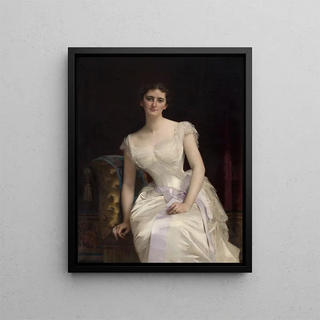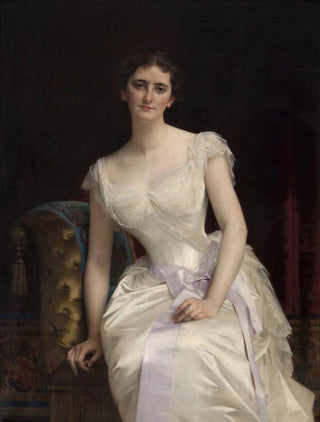Portrait painting of Mary Victoria Leiter, future Lady Curzon of Kedleston, vice-queen of India - Alexandre Cabanel | Art print


View from behind

Frame (optional)
Reproduction Portrait of Mary Victoria Leiter, future Lady Curzon of Kedleston, Vicereine of India - Alexandre Cabanel – Captivating Introduction
The portrait of Mary Victoria Leiter, future Lady Curzon of Kedleston, by Alexandre Cabanel, is an iconic work that embodies the elegance and refinement of the 19th century. This canvas, distinguished by its striking beauty, offers a fascinating glimpse into the aristocratic life of the era. Mary Victoria Leiter, whose delicate face and graceful bearing captivate the viewer, is depicted with a finesse that testifies to Cabanel's exceptional talent. This portrait is not merely a simple representation; it also evokes the personality and status of its subject, a woman who would become Vicereine of India, a role of great importance within the British Empire. Through this work, the viewer is transported to a world where art and history intersect, revealing layers of meaning and emotion.
Style and uniqueness of the work
Cabanel's style is undeniably marked by the academic movement, but he often transcends the conventions of his time. In this portrait, rich colors and meticulously detailed elements create an atmosphere that is both intimate and majestic. The sumptuous drapery of Mary Victoria's dress, as well as the sparkle of her jewelry, are rendered with precision that demonstrates the artist's technical mastery. Light plays a crucial role in the composition, illuminating the young woman's face and emphasizing her gentle, reflective expression. This play of light and shadow, typical of Cabanel's approach, gives the work emotional depth that invites contemplation. Every element of the portrait, from Mary Victoria's delicate features to the ornamental details of her clothing, contributes to creating an image that is both realistic and idealized, symbolizing an era where beauty and power were intimately connected.
The artist and his influence
Alexandre Cabanel, one of the most prominent painters of his time, established himself in the art world thanks to his exceptional talent and keen sense of aesthetics. Trained at the École des Beaux-Arts in Paris, he was influenced by masters such as Jean-Auguste

Matte finish

View from behind

Frame (optional)
Reproduction Portrait of Mary Victoria Leiter, future Lady Curzon of Kedleston, Vicereine of India - Alexandre Cabanel – Captivating Introduction
The portrait of Mary Victoria Leiter, future Lady Curzon of Kedleston, by Alexandre Cabanel, is an iconic work that embodies the elegance and refinement of the 19th century. This canvas, distinguished by its striking beauty, offers a fascinating glimpse into the aristocratic life of the era. Mary Victoria Leiter, whose delicate face and graceful bearing captivate the viewer, is depicted with a finesse that testifies to Cabanel's exceptional talent. This portrait is not merely a simple representation; it also evokes the personality and status of its subject, a woman who would become Vicereine of India, a role of great importance within the British Empire. Through this work, the viewer is transported to a world where art and history intersect, revealing layers of meaning and emotion.
Style and uniqueness of the work
Cabanel's style is undeniably marked by the academic movement, but he often transcends the conventions of his time. In this portrait, rich colors and meticulously detailed elements create an atmosphere that is both intimate and majestic. The sumptuous drapery of Mary Victoria's dress, as well as the sparkle of her jewelry, are rendered with precision that demonstrates the artist's technical mastery. Light plays a crucial role in the composition, illuminating the young woman's face and emphasizing her gentle, reflective expression. This play of light and shadow, typical of Cabanel's approach, gives the work emotional depth that invites contemplation. Every element of the portrait, from Mary Victoria's delicate features to the ornamental details of her clothing, contributes to creating an image that is both realistic and idealized, symbolizing an era where beauty and power were intimately connected.
The artist and his influence
Alexandre Cabanel, one of the most prominent painters of his time, established himself in the art world thanks to his exceptional talent and keen sense of aesthetics. Trained at the École des Beaux-Arts in Paris, he was influenced by masters such as Jean-Auguste
12,34 €






